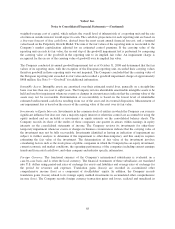Yahoo 2008 Annual Report Download - page 74
Download and view the complete annual report
Please find page 74 of the 2008 Yahoo annual report below. You can navigate through the pages in the report by either clicking on the pages listed below, or by using the keyword search tool below to find specific information within the annual report.Yahoo! Inc.
Notes to Consolidated Financial Statements—(Continued)
weighted-average cost of capital, which reflects the overall level of inherent risk of a reporting unit and the rate
of return an outside investor would expect to earn. The cash flow projections for each reporting unit are based on
a five-year forecast of free cash flows, derived from the most recent annual financial forecast, and a terminal
value based on the Perpetuity Growth Model. The sum of the fair values of the reporting units is reconciled to the
Company’s market capitalization adjusted for an estimated control premium. If the carrying value of the
reporting unit exceeds its fair value, the second step of the goodwill impairment test is performed by comparing
the carrying value of the goodwill in the reporting unit to its implied fair value. An impairment charge is
recognized for the excess of the carrying value of goodwill over its implied fair value.
The Company conducted its annual goodwill impairment test as of October 31, 2008 and determined that the fair
values of its reporting units, with the exception of the European reporting unit, exceeded their carrying values
therefore goodwill in those reporting units was not impaired. The Company concluded that the carrying value of
the European reporting unit exceeded its fair value and recorded a goodwill impairment charge of approximately
$488 million. See Note 5—“Goodwill” for additional information.
Intangible Assets. Intangible assets are amortized over their estimated useful lives, generally on a straight-line
basis over less than one year to eight years. The Company reviews identifiable amortizable intangible assets to be
held and used for impairment whenever events or changes in circumstances indicate that the carrying value of the
assets may not be recoverable. Determination of recoverability is based on the lowest level of identifiable
estimated undiscounted cash flows resulting from use of the asset and its eventual disposition. Measurement of
any impairment loss is based on the excess of the carrying value of the asset over its fair value.
Investments in Equity Interests. Investments in the common stock of entities in which the Company can exercise
significant influence but does not own a majority equity interest or otherwise control are accounted for using the
equity method and are included as investments in equity interests on the consolidated balance sheets. The
Company records its share of the results of these companies one quarter in arrears within earnings in equity
interests on the consolidated statements of income. The Company reviews its investments for other-than-
temporary impairment whenever events or changes in business circumstances indicate that the carrying value of
the investment may not be fully recoverable. Investments identified as having an indication of impairment are
subject to further analysis to determine if the impairment is other-than-temporary and this analysis requires
estimating the fair value of the investment. The determination of fair value of the investment involves
considering factors such as the stock prices of public companies in which the Company has an equity investment,
current economic and market conditions, the operating performance of the companies including current earnings
trends and forecasted cash flows, and other company and industry specific information.
Foreign Currency. The functional currency of the Company’s international subsidiaries is evaluated on a
case-by-case basis and is often the local currency. The financial statements of these subsidiaries are translated
into U.S. dollars using period-end rates of exchange for assets and liabilities and average rates of exchange for
the period for revenues and expenses. Translation gains (losses) are recorded in accumulated other
comprehensive income (loss) as a component of stockholders’ equity. In addition, the Company records
translation gains (losses) related to its foreign equity method investments in accumulated other comprehensive
income (loss). The Company records foreign currency transaction gains and losses, realized and unrealized in
68
























